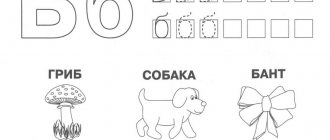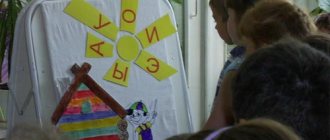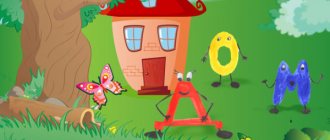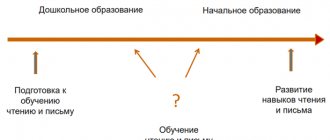Summary of a literacy lesson on the topic “Vowel letter Yoyo”, 1st grade
Objectives:
- introduce children to the new letter E; - teach to read it in words and syllables; — improve children’s reading techniques; — instill a love for the native language, its diversity, secrets and features; - instill an interest in books; -development of oral speech; - development of logic and intelligence.
Equipment:
- image of a hedgehog; - the image of the letter E; — tables and applications for speed reading; - book by I.I. Akimushkina “Once upon a time there was a hedgehog” and an encyclopedia about the animal world “All about animals. From A to Z". Translation by I. Gorelik. Ed. "Swallowtail" 2003
During the classes:
1. Organizational moment.
- Hello, guys, sit down! Today we have a difficult lesson with you. We will try to discover another secret of the Russian language associated with a letter... And we will find out which one later. Let's get into a working mood, you have a lot to talk about today, so we need to stretch our necks
2. Physical education minute.
- Sit down, children, keep your back straight. As you count, tilt your head forward, backward, left, right. (We do this 3-4 times). Try to touch your head to your chest and shoulders, but do not raise your shoulders. Okay, that's enough.
3. Work on speech development.
To learn the secrets of the new letter, we need an assistant, and he will appear if you guess my riddle:
Angry touchy lives in the wilderness of the forest; There are a lot of needles, a lot of them, but not a single thread.
- Who is this? (Hedgehog). Well done, and here he himself has appeared. (Showing a picture of a hedgehog) - Let’s find related words for the word hedgehog. (hedgehog, hedgehog, hedgehog, hedgehog, hedgehog...) - But it seems to me that you forgot another related word - YOLKA. After all, too, with needles... (Children's answers) - In fact, children, these words are not related, since they do not have a common part of the word, but only one letter in common. - Do you like this hedgehog? Let's describe it, create a verbal portrait. Just an agreement: we will try to compose whole sentences, not individual words. Let's start with the face... (Description of children). Now let's move on to the hedgehog's body, how would you describe it? (Children's answers). And look at the legs of the hedgehog... (Description of children).
4. Introducing the new letter E.
- Well done boys! The hedgehog really liked your portrait. For this he brought you a new letter on needles. What kind of letter is it (he) if the assistant is a hedgehog? (Yo). - Let's say it three times and determine whether it is a vowel or a consonant? (vowel) - How many sounds does it consist of? (Of two [Y'] and [O]). - Look at him! (I show the letter E). Little E loves to play hide and seek with Yotik; it has a hammer because it can be stressed, and it also has the property of making the preceding consonant soft! - Now we need to place our letter in the Bukvinsk house. Think about what floor, what letters will we put him on? (To vowels, with iotics “i”, “e”). And under what letter? (“o”) Why? (The letter “ё” also has a sound [o]) -Okay! Now let’s make gifts for our new home, remember the words with the letter e. (Christmas tree, ruff, gun, honey, ice...). - And the second gift for our little letter will be a game: I will name the words, and you will clap your hands only when the word begins with the letter E. Get ready! Started:
tree, blackberry, nimble, raccoon, ruff, spruce, hedgehog, bright, spinning top apple.
- Well, I think the little letter was pleased with your work. Now let's practice reading syllables and words with this letter.
5. Warm-up (Work on articulation).
We read the columns written on the board in unison. The first time we read the column slowly, clearly pronounce the sounds and pay attention to the softness of the consonants, the second time - faster, and the third time - quickly, moving along the column first down and then up. Then we move on to the next column
THO NOSE - CARRYED GRE VE WHO - DRIVED EVIL NY DIT - ROAR SVYO MOD - HONEY PLOE RYO VOL - VOL GNE LE MOL - CHALK STAR 6. Speed reading.
Now it's time for a minute of speed reading. Pick up application No. 1, find the second column. We got ready and started. (After a minute) Stop! Now calculate your result and write it down on the card. If you cannot count on your own, put a tick next to the word, I will help you with the count during recess.
7. Physical education minute.
Let's take a little rest. Take your ears with two fingers and, pressing lightly on them, move first up and then down. (We do this 3-4 times).
8. Work on speech development.
We rested a little, now it’s time to get to work. Otherwise, the hedgehog was already waiting for you and came up with the next task. He very often heard different words from people and always wanted to ask: why do we people say that? And his first word: shrink. Are we really turning into hedgehogs? - Let's speculate, when do we shrink? (It’s cold, scary, we’re hiding). - Try to imitate this pose. (Children show). — Doesn’t she remind you of anyone? (A hedgehog does this out of fear or cold). “That's why people say that.” - Well, you’ve dealt with the first question, listen to the second: why do we call one forest bush a blackberry? Is this a berry for hedgehogs? (Children's answers that the blackberry bush has needles like a hedgehog, for this similarity they gave it such a name) - Well done! And the second question was overcome! Let's move on to the third, most difficult one. People often say: keep a tight rein on things. What kind of mittens are we talking about? Have you, children, heard such an expression? (No) - Well, then I’ll have to explain to the hedgehog what kind of mittens these are, and at the same time you’ll listen. In fact, there are no tight reins, but we use this expression if we need to call someone to order, to discipline them. Let me give you an example: in our class there are children who do not try very hard to write well and I scold them for this, I monitor their work more closely, I assign additional tasks, i.e. I keep it with a tight rein. Maybe you can give some examples yourself now? (Children's stories). Finally, we coped with the hedgehog’s tricky questions, and for this he prepared for us the solution to another secret of the letter ё, the fairy tale “Why is E always stressed.” From this fairy tale you will learn where the two bumps at the top of the letter e came from - oh, no! - two points. (text is printed on the board. Read in chorus)
One day the letter E ran into the forest. Suddenly a strong wind blew, the letter E became scared, and she hid under a spruce tree. The spruce swayed from the wind, and two cones fell on the letter E, which caused cones to form on E’s head. From this it turned into another - the letter E. After this incident, the letter E is always stressed.
— Did you like the hedgehog’s fairy tale? But it’s not for nothing that we often say: a fairy tale is a lie, but there is a hint in it, a lesson for good fellows. What lesson did you learn from this fairy tale? (The letter е is always stressed). - Let's check it out! Read these words in chorus, they contain the letter e (the words are printed on the board)
YOUR TREE HEDGEHOG STUMM ANIMAL FUNNY KITTEN
Now we will read each word separately and determine the stressed vowel. (We do it) Well, are you convinced? Remember: the emphasis always falls on Yo.
9. Summary.
- The lesson is coming to an end.
Let's repeat what letter we met today? (“е”) - How many sounds does it consist of? ([й'],[о]) - What letter is this, vowel or consonant? (vowel) - What other interesting things did you remember about the letter? (makes the preceding consonant soft, always stressed). - Who helped us in our work? (hedgehog) Let's thank him! — Guys, if you are interested in this animal and want to know more about it, I suggest you read these books. (I show books by I. Akimushkin “Once upon a time there was a hedgehog” and the encyclopedia “All about animals. From A to Z”). The first book contains many illustrations and stories about the habits of a hedgehog, and the second book is more serious, there is scientific information about hedgehogs. I hope you will heed my recommendation! - Oh, yes, I almost forgot! As a farewell, the hedgehog came up with one last riddle: How does EVERYTHING end? Did you guess it? (with the letter E) For the full text of the material Summary of a literacy lesson on the topic “Vowel letter Eyo”, grade 1, see the downloadable file
. The page contains a fragment.
| Author: Irina Viktorovna Artemyeva → Iritka 12/14/2010 6 46211 4529 | Comment |
Thank you for your mark. If you want your name to be known to the author, log in to the site as a user and click Thank you again. Your name will appear on this page.
Login | Registration
Have an opinion? Leave a comment
Task for preschoolers: printed letter E
It is difficult for young children to perceive information only by ear, so it is better to do exercises that also involve eye contact with objects.
Exercise 1
Write E and E in three different colors, for example red, blue, green.
Task 2
Give examples of 3 animals whose names begin with E. Suitable words: raccoon, echidna, unicorn.
Task 3
Name three words starting with E. For example, Christmas tree, ruff, hedgehog.
In one of the tasks, the child must say a word starting with Yo, for example Hedgehog.
Task 4
Circle all the E and E in the presented row: A c g v E l e v Sh f m i E y c e f X S F sh k e e k.
Task 5
Name three names that have E in them.
Task 6
Make up five words that contain E.
Task 7
Determine the place of the given sound in the listed words: eve, spruce, bear, hay, foam, hedgehog.
Goals and objectives
The main goal of the classes is for the child to master the rules for writing the letter E and the principles of using it in words of different parts of speech, as well as the development of recognition skills for this symbol.
Teaching a child to distinguish the letter E from others, to write it beautifully and legibly, to consciously use it in words, and to pronounce this sound correctly are the main tasks. It is advisable to arouse interest in learning letters with the help of fairy tales, poems, riddles and exciting games for preschoolers.
Learning the alphabet with young children is difficult, but if you conduct lessons on the topic “Letter E” correctly, then problems will no longer arise throughout the entire training.






